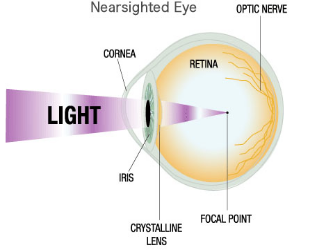OPTIONS FOR 40 AND YOUNGER

During childhood, people with normal vision have the ability to focus on near objects as well as on objects that are far away. They can switch focus from near to far vision allowing a continuous range of vision. This is called accommodation. With increasing age, that ability to focus and to switch focus decreases. By the time most people reach their forties, they need an aid, such as reading glasses or bifocals, to focus on close up objects . This condition is called presbyopia. Treatment options for nearsightedness, farsightedness and astigmatism therefore change based on the age of the patient and the visual requirements of the patient.
IF YOU ARE NEARSIGHTED (MYOPIA)
- – You have good near vision.
- – You have poor distance vision without glasses and/or contact lenses.
- – If you wear contact lenses, the sign in front of the prescription power is a minus (-). Example: -3.50 soft contact lens power.
- – Nearsightedness (Myopia) occurs when the eyeball is too long, or the eye’s focusing mechanism (the cornea and lens) is too powerful, causing light rays to focus in front of the retina.
- – Refractive eye surgery will correct the focus of your eye, which should enable you to see well at both distance and near following your surgery.
- – As you age, the lens inside your eye will lose its ability to focus as well at near – this usually becomes evident around the age of 40. This is when many people begin using reading glasses or bifocals.
- – Refractive eye surgery will not prevent this age-related event, known as presbyopia, from occurring. You will eventually need reading glasses to see well at near.
POTENTIAL SURGICAL OPTIONS
Your complimentry LASIK examination will allow Dr. Abbas to evaluate your needs and chose the best procedure for your unique visual needs:
i-LASIK
- – This procedure uses the Customvue Wavescan to capture your eye’s unique profile that will be fed into the computer of the Excimer Laser to plan a truly customized treatment plan for your eyes.
- – The Intralase or the Zeimer LDV Femto second lasers are then used to create thin corneal flaps in the front part of the cornea. The flap is then lifted away from the cornea to alow the reshaping treatment to be placed on the cornea.
- – The Excimer laser (VISX STAR S4 OR the Allegretto Wave) permanently sculpts the patient’s visual correction into the deeper tissue of the cornea (beneath the flap). The flap is then re-positioned back in place.
PRK
- – This procedure is similar to LASIK, except that a corneal flap is not created.
- – Instead, the corneal epithelium (outermost layer) is removed and the excimer laser treatment is then applied to the surface of the cornea.
- – The epithelium slowly grows back as the eye heals, and ultimately the visual outcomes are similar to LASIK.
VISIAN ICL
- – available to patients between 21 and 45 years of age with high myopia
- – A foldable lens is inserted through surgical micro-incision and placed inside the eye just behind the iris in from of the eye’s natural lens
- – This procedure is available to patients who have high myopia who are not suitable for LASIK correction or patients who are NOT good candidates for LASIK because of thin corneas.
VERISYS PHAKIC IOL
- – This is a procedure for patients who are extremely near-sighted and outside the range of LASIK.
- – A foldable lens is inserted through a surgical micro-incision and placed inside the eye just in front of the iris (the colored part of the eye)
- – This procedure is available to patients who have high myopia who are not suitable for LASIK correction or patients who are NOT good candidates for LASIK because of thin corneas.
IF YOU ARE FARSIGHTED (HYPEROPIA)
- – Your distance vision is probably better than your near vision, but you may have difficulty at distance and near.
- – If you wear contact lenses, the sign in front of the prescription power is a plus (+). Example: +2.50 soft contact lens power.
- – Farsightedness (Hyperopia) occurs when the eyeball is too short, or the eye’s focusing mechanism (the cornea and lens) is too weak, causing light rays to focus behind the retina
- – Refractive eye surgery will correct the focus of your eye, which should enable you to see well at both distance and near following your surgery.
- – Young people who are farsighted often have “hidden” vision problems, but they can usually accommodate (overcome the visual problems by making the eye work harder) to see better. This can cause eyestrain and headaches.
- – As you age, the lens inside your eye will lose its ability to focus as well at near – this usually becomes evident around the age of 40. This is when many people begin using reading glasses or bifocals.
- – Refractive eye surgery will not prevent this age-related event, known as presbyopia, from occurring. You will eventually need reading glasses to see well at near.
POTENTIAL SURGICAL OPTIONS
i-LASIK as described above.
PRK as described above.
PRELEX
- – This procedure is offered to highly farsighted patients who are not good candidates for laser vision correction.
- – It involves removal of the natural crystalline lens of the eye using cataract surgical techniques and replacing it with a multifocal intraocular lens which allows patients to be able to see far, intermediate and at near without the help of glasses.
Ask about our cash discount.
If you would like to find out more about this exciting, once in a lifetime opportunity of turning back the clock on your vision, please contact us to see how we can restore your near vision to what it used to be when you were younger. Call us at 281-420-EYES(3937) or Schedule Online
